Motherboard Products: Intel Performance
We cannot disclose performance results yet for the Bearlake motherboards nor give general indications on how it compares to the P965 but all will be revealed on May 21st. Let's just say we were surprised with our test results over the last few weeks. (You'll have to wait to find out if we were surprised in a good or a bad way.) In the meantime we have three boards from ASUS, Gigabyte, and MSI to show you today with more coming shortly.
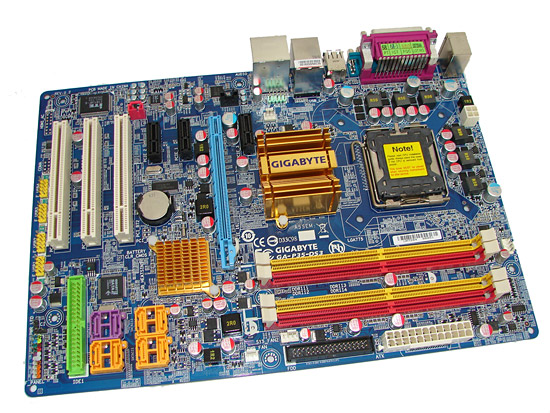
The spiritual successor to Gigabyte's highly acclaimed GA-965P-DS3 series is the new GA-P35-DS3R. The board features a single x16 PCI Express slot, two x1 PCI Express slots, and three PCI 2.2 slots. The new ICH9R chipset is also included with six SATA 3Gb/s ports, and two additional SATA 3Gb/s ports come from the now standard JMicron JMB363 chipset that also provides IDE functionality. Audio is provided by the new Realtek ALC889A chipset and the board features Gigabyte's Ultra Durable 2 technology. This technology is a combination of ferrite core choke coils, low RDS MOSFETs, and solid aluminum polymer capacitors on the board.
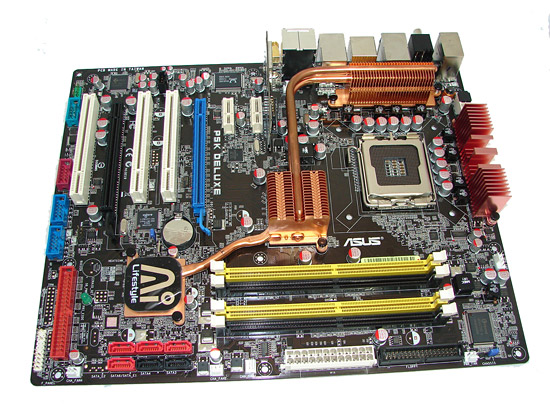
The ASUS P5K Deluxe is based on the P35 and ICH9R chipsets. The board features two x16 PCI Express slots (x16 electrical and x4 electrical for CrossFire), two x1 PCI Express slots, and three PCI 2.2 slots. The ICH9R Southbridge features six Serial ATA 3Gb/s ports with RAID 0, 1, 5, and 10 support. ASUS also supplies the JMicron JMB363 SATA controller that provides two e-SATA ports and the single IDE connector. The board is equipped with an ADI 1988B 8-channel HD audio codec and features dual Gigabit LAN. The ASUS WiFi-AP Solo IEEE 802.11g wireless card is included as is IEEE 1394a support from the Agere FW322 chipset.
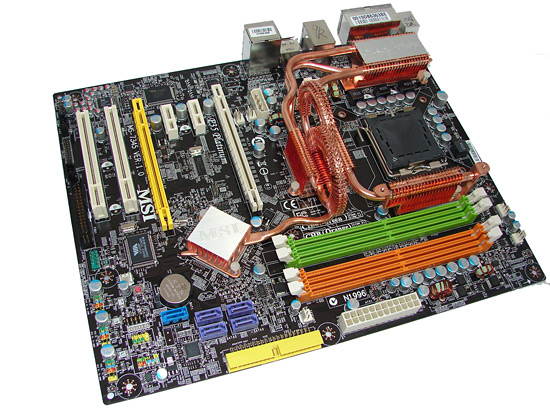
The MSI P35 Platinum is also based on the P35 and ICH9R chipsets. The board features two x16 PCI Express slots (x16 electrical and x4 electrical for CrossFire), two x1 PCI Express slots, and two PCI 2.2 slots. The ICH9R Southbridge features six Serial ATA 3Gb/s ports with MSI utilizing two for e-SATA duties. MSI utilizes the Marvell 88SE6111 chipset that provides a single 3Gb/s SATA and IDE ATA133 port on the board. The board is equipped with the new Realtek ALC888T 8-channel HD audio codec that features support for VoIP. The board features a single Gigabit LAN port and IEEE 1394a support from the VIA VT6308 chipset.
AMD uATX
We have several uATX boards featuring the AM2 processor series that we will present in our upcoming roundup that can only be described at this time as an editor killing review. The products we will briefly cover today are just a few examples of the boards that will be included. While most of our boards are based on the AMD 690G and NVIDIA 6150 technology we do have a couple of AMD/ATI RS485 boards along with a VIA K8M890 based board. We will also include results from the new NVIDIA 7050 chipset.
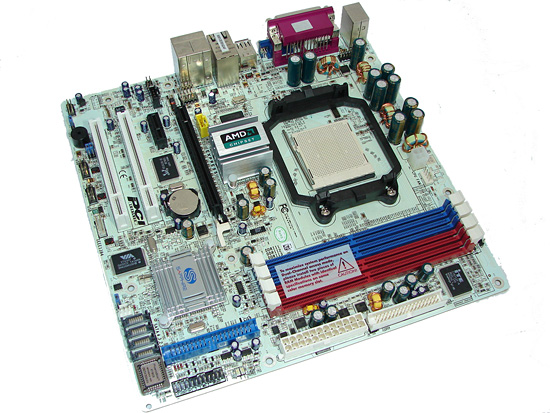
The Sapphire PI-AM2RS690MHD board is based on the AMD690G chipset that offers very good onboard video performance via the ATI X1250 with the ability to upgrade to the latest graphics card technology via the x16 PCI Express slot. The board supports 8GB of DDR2 memory, single x1 PCI Express slot, two PCI 2.2 slots, HD audio via the Realtek ALC882D, and IEEE 1394a from the VIA VT6306 chipset. The board also features HDMI, VGA, and DVI output along with four 3Gb/s SATA ports and a single IDE connector via the tried and true SB600 Southbridge. With the latest BIOS we are now over 300HTT in our overclocking tests along with the board performing superbly overall.
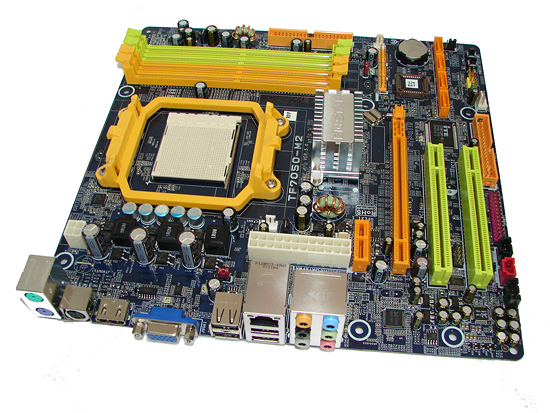
The Biostar TF7050-M2 board is based upon the new NVIDIA GeForce 7050PV and nForce 630A chipsets that offer very good system performance in a uATX form factor. The board has one x16 PCI Express slot, one x1 PCI Express slot, and two PCI slots. The board supports 4GB of DDR2 memory, HD audio via the Realtek ALC888, Gigabit LAN via the Realtek RTL-8111B Fast Ethernet, and four Serial ATA 3Gb/s ports along with a single ATA133 IDE connector. The board also features VGA and HDMI outputs. Additional details about this chipset will be available on May 15th.
We cannot disclose performance results yet for the Bearlake motherboards nor give general indications on how it compares to the P965 but all will be revealed on May 21st. Let's just say we were surprised with our test results over the last few weeks. (You'll have to wait to find out if we were surprised in a good or a bad way.) In the meantime we have three boards from ASUS, Gigabyte, and MSI to show you today with more coming shortly.

The spiritual successor to Gigabyte's highly acclaimed GA-965P-DS3 series is the new GA-P35-DS3R. The board features a single x16 PCI Express slot, two x1 PCI Express slots, and three PCI 2.2 slots. The new ICH9R chipset is also included with six SATA 3Gb/s ports, and two additional SATA 3Gb/s ports come from the now standard JMicron JMB363 chipset that also provides IDE functionality. Audio is provided by the new Realtek ALC889A chipset and the board features Gigabyte's Ultra Durable 2 technology. This technology is a combination of ferrite core choke coils, low RDS MOSFETs, and solid aluminum polymer capacitors on the board.

The ASUS P5K Deluxe is based on the P35 and ICH9R chipsets. The board features two x16 PCI Express slots (x16 electrical and x4 electrical for CrossFire), two x1 PCI Express slots, and three PCI 2.2 slots. The ICH9R Southbridge features six Serial ATA 3Gb/s ports with RAID 0, 1, 5, and 10 support. ASUS also supplies the JMicron JMB363 SATA controller that provides two e-SATA ports and the single IDE connector. The board is equipped with an ADI 1988B 8-channel HD audio codec and features dual Gigabit LAN. The ASUS WiFi-AP Solo IEEE 802.11g wireless card is included as is IEEE 1394a support from the Agere FW322 chipset.

The MSI P35 Platinum is also based on the P35 and ICH9R chipsets. The board features two x16 PCI Express slots (x16 electrical and x4 electrical for CrossFire), two x1 PCI Express slots, and two PCI 2.2 slots. The ICH9R Southbridge features six Serial ATA 3Gb/s ports with MSI utilizing two for e-SATA duties. MSI utilizes the Marvell 88SE6111 chipset that provides a single 3Gb/s SATA and IDE ATA133 port on the board. The board is equipped with the new Realtek ALC888T 8-channel HD audio codec that features support for VoIP. The board features a single Gigabit LAN port and IEEE 1394a support from the VIA VT6308 chipset.
AMD uATX
We have several uATX boards featuring the AM2 processor series that we will present in our upcoming roundup that can only be described at this time as an editor killing review. The products we will briefly cover today are just a few examples of the boards that will be included. While most of our boards are based on the AMD 690G and NVIDIA 6150 technology we do have a couple of AMD/ATI RS485 boards along with a VIA K8M890 based board. We will also include results from the new NVIDIA 7050 chipset.

The Sapphire PI-AM2RS690MHD board is based on the AMD690G chipset that offers very good onboard video performance via the ATI X1250 with the ability to upgrade to the latest graphics card technology via the x16 PCI Express slot. The board supports 8GB of DDR2 memory, single x1 PCI Express slot, two PCI 2.2 slots, HD audio via the Realtek ALC882D, and IEEE 1394a from the VIA VT6306 chipset. The board also features HDMI, VGA, and DVI output along with four 3Gb/s SATA ports and a single IDE connector via the tried and true SB600 Southbridge. With the latest BIOS we are now over 300HTT in our overclocking tests along with the board performing superbly overall.

The Biostar TF7050-M2 board is based upon the new NVIDIA GeForce 7050PV and nForce 630A chipsets that offer very good system performance in a uATX form factor. The board has one x16 PCI Express slot, one x1 PCI Express slot, and two PCI slots. The board supports 4GB of DDR2 memory, HD audio via the Realtek ALC888, Gigabit LAN via the Realtek RTL-8111B Fast Ethernet, and four Serial ATA 3Gb/s ports along with a single ATA133 IDE connector. The board also features VGA and HDMI outputs. Additional details about this chipset will be available on May 15th.










33 Comments
View All Comments
baronzemo78 - Thursday, May 3, 2007 - link
Any news when the new Bearlake X or any boards that have support for dual x16 pci express electrical for crossfire?kmrivers - Friday, May 4, 2007 - link
Actually I found some stuff out today. The 975X replacement will be the X38 boards.The intel version, which is a direct replacement to the Bad Axe 2 is the Intel DX38BT 'Bone Trail
Source: http://www.thetechrepository.com/showthread.php?t=...">http://www.thetechrepository.com/showthread.php?t=...
Here are some details on it:
DX38BT Product Highlights:
* Based on the next-generation X38 Express chipset (MCH)
* Intel Duo/Quad/Extreme (dual and quad) Core support at up to 1333MHz FSB, dual channel DDR2/DDR3 memory support with Fast Memory Access technology
* Intel ICH9 southbridge, 12 USB ports, supporting up to 6 additional PCI Express 1.1(a) lanes [physics card upgrade support], GBit LAN
* 2x PCI Express 2.0 16x ports (backwards compatable with PCI Express 1.1 specification), Crossfire is supported
* 6x SATA 3.0GB/s ports, Intel Maxtrix Storage Technology (RAID)
* Intel High Definition (HD) Technology
* Full overclocking/overvoltage options via BIOS and NEW Windows GUI utility for overclocking, including auto-tune capabilities
I have no idea where TPR got this information. Here are some details on the Bearlake chipsets:
http://www.dailytech.com/article.aspx?newsid=4588">http://www.dailytech.com/article.aspx?newsid=4588
Chadder007 - Saturday, May 5, 2007 - link
PCI Express ....2.0? Good Lord, are they going to pull another AGP on us again???vailr - Thursday, May 3, 2007 - link
I'd like to see a short summation of P35 boards having:1. No legacy parallel port
2. 4x DDR2 memory slots
3. Minimum of: 3 PCI card slots
4. Intel Matrix Raid
The 2 P35 boards known to have these 4 features are:
Asus PK5, and variants
Abit P35, and variants
Any others?
And, will DFI delay another 6 months (like they did with their just-released 965 Infinity board) before offering their version of Bearlake board?
Mogadon - Thursday, May 3, 2007 - link
While we're on the subject of heatsinks, it seems unfortunate that Gigabyte decided to use exactly the same heatsinks on their DS3R as the DS3, considering everyone that's tried to overclock with a DS3 knows how hot they get.mostlyprudent - Thursday, May 3, 2007 - link
I was glad to see a new DFI borad, but very disappointed to see it, along with the MSI 680i board, had a fan on the chipset. Come on guys...HEATPIPES! Perhpas the fans allow for better O'Cing, but having just replaced another dead one - I'm done with boards that have chipset fans!BTW, nice article. I appreciate seeing what's coming up. With so many paper launches, it's very niec to know that AT already has multiple P35 boards for testing.
lsman - Thursday, May 3, 2007 - link
I will prefer a chipset fan.because now, I have to find some 40mm fan to screw on those "$100" mobo to OC them. The NB is very hot.
And there are many cases that ppl take their heat pipe off just to find out that only 1/3 of the chipset is cover with thermal paste.
http://www.overclock.net/faqs/100443-how-reseat-as...">http://www.overclock.net/faqs/100443-how-reseat-as...
TA152H - Thursday, May 3, 2007 - link
Also keep in mind this chipset is made on 65nm lithography, not 90 or 130 like the P965 and 975 respectively. It shouldn't give off as much heat.mostlyprudent - Thursday, May 3, 2007 - link
Interestingly, most (if not all) of the complaints I hear about passive cooling solutions on MB chipsets are along the lines "that heatsink was really hot to the touch". The temperature of the heatsink is not necessarily indicative of the temperature of the underlying chipset. Stick a little fan on top of the heatsink and:1) you won't be able to feel how hot the heatsink gets anymore because you can't touch it so easily;
2) the surface of the heatsink will likely be cooler with the fan running, but that does not necessarily mean the chipset is being cooled any better; and
3) as we've seen in the recent CPU cooler reviews here, there is not always a direct correlation between temperature and overclockability (at least not a direct linear correlation throughout the range of temps and mhtz).
Besides, we've seen from ASUS and others that their passively cooled boards have no problem keeping pace with boards that sport chipset fans. I suspect the primary motivation for using these little fans is that the chipset fans are a much cheeper cooling solution (from a design standpoint).
Stele - Thursday, May 3, 2007 - link
Passive cooling solutions have the significant advantages of being perfectly silent and, having no moving parts, are practically immune to mechanical failures - and the thermal failures resulting from that. Heatpipes, in particular, are also far more effective than plain copper heatsinks in removing heat from the component(s) - they generally have an effective thermal conductivity up to thousands of times that of solid copper of equivalent cross-section. Furthermore, heatpipes allow heat to be quickly and efficiently transported from the source of the heat (usually chipset components tucked amongst many other components/expansion cards) to another location where dissipation/cooling may be easier (e.g. in the path of airflow from CPU fan and/or in a more open space where better airflow can be obtained).If the component(s) become exceedingly hot, one possible and typical cause is that the manufacturer did not deploy a solution sufficiently capable of handling the heat dissipated under certain circumstances (some manufacturers may design their solutions with a 25-30°C ambient temperature in mind, vs. the 30-40°C more commonly found in packed casings in say, warm climates). The other reason is that some manufacturers have a target spec - say, keep NB operating at x°C or less under ambient temperatures of say, 30°C - and then go on to spec a fairly high temperature for x - say, 60°C - so that the NB operates under the maximum allowable temperature (even if barely) yet ensures that the cooling solution needed would be inexpensive and simple.
Both these are mistakes/negligence in the engineering - under-specifying the desired cooling performance of the cooling solutions to be used - and are equally possible when designing in HSFs too, so it's a bit unfair to say that all overheating proablems are entirely because of the use of passive solutions per se. Same goes for heatsink seating issues - applies to both HSF and passive solutions and depends more on operator training/care than actual heatsink used, though a little more is required for exotic heatpipe system installations than simpler passive solutions.
All told, however, a passive cooling system still has the edge over traditional chipset fans, which is why more and more motherboards are deploying them instead of tiny screaming meemies. :)